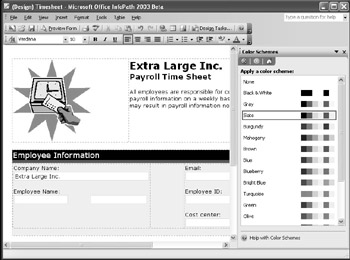Chapter 3: Generating XML Forms

Introduction
XML has become the industry-standard format for data interchange and is the core -enabling technology of InfoPath. One reason XML was successful in gaining industry acceptance is its self-describing nature. Unlike HTML, XML isn t based on a set of predefined tags and data structures. XML documents can contain any type of structured data elements delimited by a set of descriptive tags that act as both the record boundaries and built-in data documentation. When viewed together, the combination of the hierarchical data elements enclosed by descriptive tags defines a vocabulary of data.
The lack of predefined data elements and structure can inherently make XML files unpredictable. Seeing this as a problem, the industry standards body, the World Wide Web Consortium (W3C), created a new XML-based language for describing these documents. The goal of this specification was to provide a way to describe XML documents and structures, support XML namespaces, promote reusability, enable inheritance, and provide predictability. The result of this was an XML-based vocabulary to describe XML-based vocabularies.
The industry recommendation that describes the structures of this language is broken into three parts : XML Schema Part 0: Primer, XML Schema Part 1: Structures, and XML Schema Part 2: Data Types. Using this standard as the starting point, this chapter covers how you can use InfoPath to develop form-based solutions that provide both data validation and formatting. We will also cover how InfoPath provides an extensible object model that enables developers to programmatically access and control XML-based form data to extend InfoPath solutions.
EAN: 2147483647
Pages: 111
- The Effects of an Enterprise Resource Planning System (ERP) Implementation on Job Characteristics – A Study using the Hackman and Oldham Job Characteristics Model
- Context Management of ERP Processes in Virtual Communities
- Data Mining for Business Process Reengineering
- Healthcare Information: From Administrative to Practice Databases
- Relevance and Micro-Relevance for the Professional as Determinants of IT-Diffusion and IT-Use in Healthcare
- Article 314 Outlet, Device, Pull, and Junction Boxes; Conduit Bodies; Fittings; and Handhole Enclosures
- Article 334 Nonmetallic-Sheathed Cable Types NM, NMC, and NMS
- Article 352 Rigid Nonmetallic Conduit Type RNC
- Notes for Tables 11(A) and 11(B)
- Example No. D2(c) Optional Calculation for One-Family Dwelling with Heat Pump(Single-Phase, 240/120-Volt Service) (See 220.82)